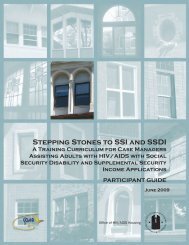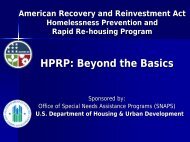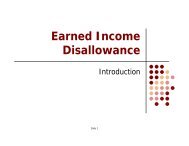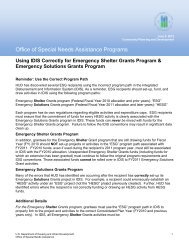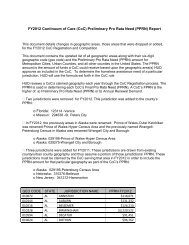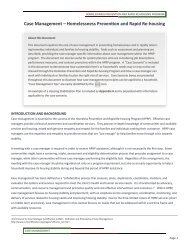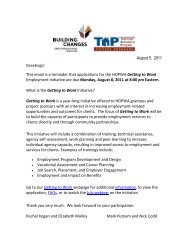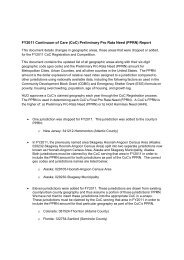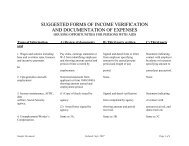CPD Monitoring Handbook 6509.2 Rev-6 - OneCPD
CPD Monitoring Handbook 6509.2 Rev-6 - OneCPD
CPD Monitoring Handbook 6509.2 Rev-6 - OneCPD
Create successful ePaper yourself
Turn your PDF publications into a flip-book with our unique Google optimized e-Paper software.
<strong>6509.2</strong> REV-6<br />
C. File Selection and Sampling. As described in Chapter 2, the risk analysis process will<br />
be used to determine which grantees and areas should be reviewed. The term “files”<br />
for compliance monitoring purposes, includes files from the grantee, the subgrantee, or<br />
a combination of both, as applicable. Once that process has been completed, where it<br />
is indicated that a file review is necessary to answer Exhibit questions, the HUD<br />
reviewer should consider the following factors when determining the specific files that<br />
will comprise the review sample:<br />
1. Where feasible, initial file selection should be made using a random selection<br />
method.<br />
2. The reviewer would consider adding more files to this selection in order to:<br />
i. Include a file or files from each staff person working in the respective<br />
program area being monitored.<br />
ii. Expand the sample, if possible, to include additional files with the same<br />
characteristics, if indicated by the severity or nature of any problems(s) noted<br />
during the review of the initial selection (for example, same problem category,<br />
same staff person, same activities or other characteristics).<br />
This expanded sampling aids in determining whether problems are isolated events<br />
or represent a systemic problem. Note, however, that Exhibit 8-4, “Guide for<br />
<strong>Rev</strong>iew of HPRP Program Participants,” is mandatory for all HPRP projects.<br />
3. The reviewer may also add files to the selection from any HPRP program that the<br />
HUD reviewer has reason to believe may have compliance problems or that is<br />
substantially different in terms of size, complexity, or other factors from other<br />
projects the HPRP grantee has undertaken.<br />
8-4<br />
MONITORING THE NEIGHBORHOOD STABILIZATION PROGRAM 1 (NSP-1).<br />
This part of Chapter 8 provides guidance for conducting comprehensive monitoring of<br />
Neighborhood Stabilization Program 1 (NSP-1) projects. It contains seven Exhibits<br />
specific to monitoring this Program, covering: NSP-1 Program Progress; NSP-1 National<br />
Objective of Benefit to Low-, Moderate-, and Middle-Income Persons; NSP-1<br />
Cooperative Agreements; NSP-1 State Requirements; NSP-1 Continued Affordability;<br />
NSP-1 Eligible Use C: Establish Land Banks; and NSP-1 Fair Housing and Equal<br />
Opportunity Requirements.<br />
A. Program Overview. HUD awarded funds for NSP-1 on a formula basis, for the<br />
purpose of providing emergency assistance for redevelopment of abandoned and<br />
foreclosed homes and residential properties. HUD awarded NSP-1 funds through the<br />
approval of a Substantial Amendment to the 2008 Consolidated Annual Action Plan.<br />
The submission of the substantial amendment required grantees to design their<br />
program around a set of NSP-1 eligible uses that correlated with a number of eligible<br />
activities from the CDBG entitlement regulations.<br />
8-3 04/2010



